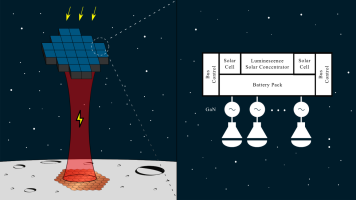Wireless Power Transmission for long-range distances suffers from several problems: conversion efficiency from solar energy to radio frequency signals, assembly and deployment of very large antenna arrays and antenna beam efficiencies. Our idea is to create a solar power satellite tile that can be expanded as needed to create a massive structure for solar conversion and power transmission to moon stations. This tile will include a state of the art luminescent solar concentrator, that exploits solar radiation by using large-area devices that need a minimal amount of photovoltaic material (only at the substrate edges). At the same time, it can up/down convert the energy of input signals, allowing broader wideband solar harvesting and the fine tuning of the solar radiation with the solar cells operating region. This will then be assembled with a battery pack to store energy, allowing non-stationary orbits to collect energy in sunlight areas, and deliver it only when flying over ground energy collectors. This way it is possible to supply continuous power to moon stations, even when they do not have direct sunlight incidence. The previous DC structure will be connected to antenna cells, each consisting of a Gallium Nitride (GaN) RF oscillator connected to a radiating element and a focusing element. These will then be connected together into sub-arrays, completing the tile. The tile will be self-powered and have a simple bus connection in each side, to enable coupling to nearby tiles. When connected together, the tiles will constitute a large SPS array that should have a central controller unit, consisting of an on-board computer that will implement algorithms to optimize and tune each sub-array phase change, creating in this way a focus of energy. A feedback channel pilot will be used to optimize the beam focus of the SPS. An analysis of the orbital dynamics will be necessary to arrive at the optimal frequency of operation, as well as the expected outputted power per orbit.

